Spotlight Publication: “Engineering endosomolytic nanocarriers of diverse morphologies using confined impingement jet mixing” published in Nanoscale

Co-first author Hayden Pagendarm is a 4th year PhD student in Biomedical Engineering program advised by Dr. John T. Wilson. His research is focused on the development of novel technologies to induce antigen-specific immune tolerance, with a focus on engineered proteins and extracellular vesicles. Co-first author Payton Stone is a 4th year PhD student in Chemical and Biomolecular Engineering, also advised by Dr. John T. Wilson. His research is centered around the development of polymeric nanocarriers for the delivery of therapeutic nucleic acids. The co-authors include a team of researchers from both Vanderbilt University and Northwestern University who contributed to this collaborative research project, including two former VINSE REU undergraduate students Mina Aziz and Lauren Hubert.
In this work, recently published in the journal Nanoscale, the research team demonstrated that flash nanoprecipitation (FNP) using a confined impingement jet (CIJ) mixer could be used to reproducibly formulate pH-responsive polymeric nanoparticles of well-defined and uniform sizes and morphologies. This is notable as CIJ mixing is an industrially scalable process, and scale-up is one of the major hurdles in advancing a novel therapy from the benchtop to the clinic. Additionally, CIJ mixing facilitates the loading of molecules with a variety of physicochemical properties, making this a versatile formulation approach to produce multiple types of drug-loaded, therapeutic nanoparticles. The research team also demonstrated that the morphology of the resultant nanoparticles could be tuned via modulation of the hydrophilic mass fraction of the di-block copolymer used to make the nanoparticles. Finally, the research team demonstrated that nanoparticles formulated via CIJ mixing could encapsulate the innate immune agonist 2’,3’-cyclic guanosine-adenosine monophosphate (cGAMP) and facilitate its delivery to the cytosol to a degree capable of slowing tumor growth and extending survival in a murine model of melanoma. Collectively, this work will help advance the clinical translation of stimuli-responsive drug carriers to address a variety of diseases.
